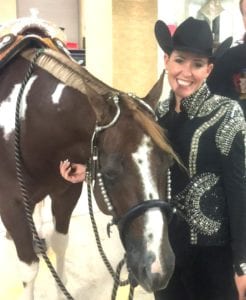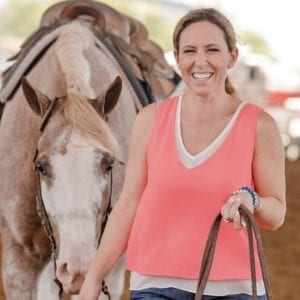There is a wise saying that, “Life happens while you’re busy making plans for it.” And this couldn’t be truer in the horse training context.
In order to find success in the ring, we’re told to lay out a general plan with smaller goals along the way in hopes of accomplishing your biggest dreams. But, what happens when things inevitably don’t go as planned? You want to give your horse a chance to succeed, but it can be difficult to know when it is appropriate and fair to change course.
In part 1 of this series on knowing when to quit, we spoke with AQHA and APHA trainer Carly Parks to get a trainer’s perspective on what signs to look for to indicate that it is time for a change of plans for you and your horse.
Your Horse is Physically Uncomfortable
 Perhaps the most obvious sign that something needs to give is indicators that your horse is not physically capable of holding up to your expectations.
Perhaps the most obvious sign that something needs to give is indicators that your horse is not physically capable of holding up to your expectations.
These signs include: lameness, soreness, an inability to hold the required frame over time, and refusal to perform certain physical tasks.
“If your horse is sore at the end of show days or is indicating they cannot hold up to the work load required to accomplish your goal, that is a sign that you need to hit the pause button and figure out what is going on,” Parks advises.
“Sometimes it’s a simple fix, like they need a little time off or maybe joint injections for better lubrication. And other times there is something serious happening and the horse is incapable of giving you what you are asking. Unfortunately, they can’t tell us, so you need to observe the signs and be willing to do some investigation to discover the source.”
Wade explains, “If it is a problem that can be addressed, you might just be a little delayed in your plans. If it is a problem that cannot be fixed, then it may be time to find something they are physically capable of holding up to.”
Your Horse is Frustrated
While the physical component may be a little more obvious, there is also a mental component to your horse’s success.
 “I’ve had some very physically talented horses that are not mentally capable of being show horses at the highest levels,” Parks laments.
“I’ve had some very physically talented horses that are not mentally capable of being show horses at the highest levels,” Parks laments.
Parks says that signs they aren’t mentally capable of participating in your plans include: they aren’t learning after months of training; they are unwilling to participate in their training; they won’t cooperate for their amateur, but act fine for a professional; etc. These are all indicators that it is time for a change in plans.
“Horses with mental/personality issues inevitably take more time to train on. Therefore, the only way these horses end up working out for their owner’s plan is where the owner is patient and willing to spend more time and resources on their talent. But, a horse with both mental and physical impediments simply isn’t going to cut it at a high level of showing and it may be time to cut your losses.”
Try Other Things and Evaluate the Difference
A change of plans doesn’t mean you need to give up on your dreams with your horse. But, it may mean those dreams need a slight alteration.
 Wade says, for example, you may purchase a horse with ambitions of turning them into a western pleasure horse and there are signs they simply aren’t going to find success in that discipline. That doesn’t mean the animal is hopeless, it just means you may need to consider other classes where they are more likely to find success (i.e., trial, horsemanship, or western riding).
Wade says, for example, you may purchase a horse with ambitions of turning them into a western pleasure horse and there are signs they simply aren’t going to find success in that discipline. That doesn’t mean the animal is hopeless, it just means you may need to consider other classes where they are more likely to find success (i.e., trial, horsemanship, or western riding).
“I think the kindest thing you can do for a horse and their trainer is be willing to maximize their talent instead of trying to fit a square peg into a round hole,” Parks says.
If a horse isn’t coming along for the rider’s intended discipline, Parks likes to evaluate where they could find success and make new goals in that area. This may mean changing classes or even changing the caliber of shows you take them to.
“Not every horse can show at the Congress or the World Show, but that doesn’t make them worthless,” Parks encourages. “That horse could be fantastic on a local circuit or zone level. These animals make a great stepping-up horse for their owner to find intermediate success on, and then there is the option to sell them as a seasoned winner in order to afford the dream at the next level.”
Chances are, if you are willing to maximize your horse’s value and meet them where they are at both physically and mentally, you will find success – it just may not be where you envisioned it.
The Horse isn’t Meeting Your Budgeted Time Frame
Finally, Parks recommends you know your budget and a time frame for your resources at the outset of training and communicate that clearly with your trainer.
 “The reality is, it is hard for a trainer to determine when a horse will be successful…but, we can have a pretty good idea of one that won’t be. And this can be hard for us to share with a client because they are invested both emotionally and financially,” Parks admits.
“The reality is, it is hard for a trainer to determine when a horse will be successful…but, we can have a pretty good idea of one that won’t be. And this can be hard for us to share with a client because they are invested both emotionally and financially,” Parks admits.
Parks has found that, when an owner explains their goal and their budget, it is much easier to provide an honest assessment of whether the horse is capable of success on that plan.
“Generally, we can tell whether a 2 year old has real potential at a high level in 30-60 days of riding. Now, there is a lot of time and training that goes into them after that and the amount of time is unique to each horse. But, experienced trainers can tell you when it just isn’t there.”
When it comes to working with an already broke horse, Parks says that it is often easier to assess their talent for a client’s goals and what goals are appropriate under the circumstances.
“Having open communication with your trainer about your dreams and what you can afford is the best way to determine whether your goals are possible. You need to be fair to your trainer and the horse and give them time to meet your expectations, but it is also unreasonable to sink money and time into an animal or plan that isn’t going to cut it.”
***
 In closing, Parks reminds us, “At the end of the day, we are dealing with animals and not machines. There is no crystal ball to tell you what will happen down the road and there will always be bumps in the road. You need to be in this sport because you love horses and enjoy the process.”
In closing, Parks reminds us, “At the end of the day, we are dealing with animals and not machines. There is no crystal ball to tell you what will happen down the road and there will always be bumps in the road. You need to be in this sport because you love horses and enjoy the process.”
Ultimately, “You need to be fair to the animal and understand that, just because you want something, doesn’t mean they can give it to you. The best way to be a good owner is to be flexible with your plans to allow your horse to determine where their talent is and then have your trainer capitalize on that to meet their full potential.”
Stay tuned for parts 2 & 3 of our ‘Knowing When To Quit’ series where we will discuss knowing when to move on from your horse and knowing when to move on from a client.









